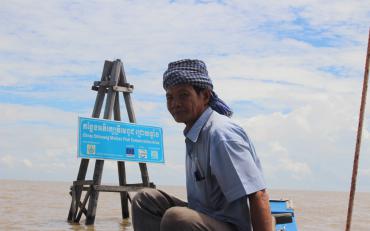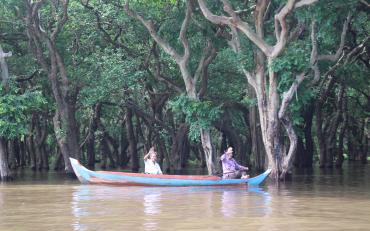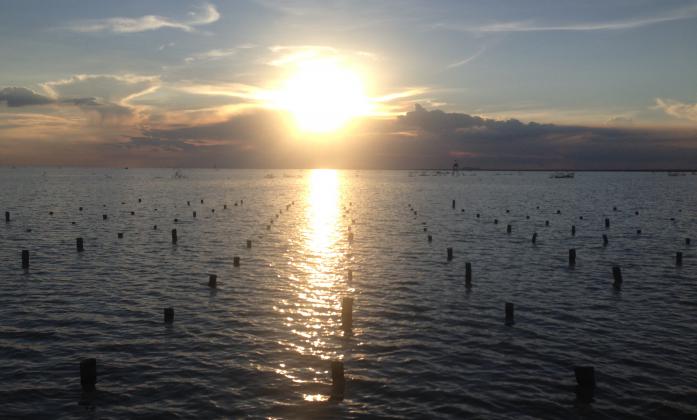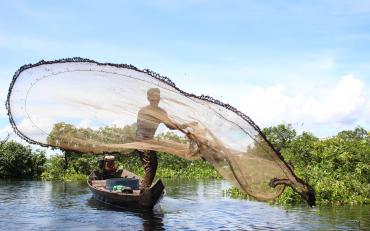By Colton Naval and Sorn Pheakdey, IUCN Cambodia ~ "Water is life in the Tonle Sap floodplain of Cambodia. Each year, a combination of heavy rains and the flooding of the Mekong River, which reverses the flow of the Tonle Sap River, expands the Tonle Sap Lake, inundating its surrounding floodplain and its wetland forests. The waters bring fish and nutrients, deepening migratory channels and fish pools, covering wetland forest and providing important habitats for a variety of aquatic and bird species.
As one of the world’s most productive inland fisheries, and a world cultural and environmental heritage site recognized by both UNESCO and the Ramsar Convention, the Tonle Sap is truly one of the world’s most unique freshwater ecosystem. It is also a system under threat by rapid environmental change, poor management and weak governance. Not only does this have implications for the wider Tonle Sap ecosystem, but for the livelihoods of millions of Cambodian citizens, who depend on this ecosystem for natural resources, especially fish.
To address this, IUCN, together with Fisheries Action Coalition Team (FACT), began implementing a four year (2013-2016) EU-NSA project on strengthening the capacity of fishing communities in the Tonle Sap to manage and conserve their natural resources. These efforts have largely focused on the establishment of fish conservation areas (FCA) within three Tonle Sap communes: Phlov Touk, Kampong Phluk and Peam Bang-Boeung Chhmar. In the process, IUCN and FACT have tackled several sustainable development goals - addressing the challenges of climate change (SDG 13), working to reduce rural poverty and food insecurity (SDG 1; SDG 2), establishing equal opportunities for men and women (SDG 5), and of course, working to build on the sustainable development and ecosystem conservation objectives of the Cambodian Government, European Union, UNESCO, and Ramsar Convention (SDG 17). Water has been the unifying ingredient in this complex equation, with IUCN and FACT’s work playing an integral role in maintaining the integrity of the Tonle Sap ecosystem and improving its governance.


2) Flooded forest is life for Kampong Phluk community fishersies.
3) Mr Om Chhim, CFiC member, sits in front of one of six demarcation towers and the FCA signboard in Kampong Phluk CFi.
One of the project’s earliest successes was the successful negotiation and demarcation of FCA boundaries within each target community. IUCN and FACT worked closely with both community members, including local fishers, community fisheries committees (CFiC) and community protected area committees (CPAC), and local authorities from the Fisheries Administration (FiA) and Ministry of Environment (MoE), to establish agreements on the location of the FCA based on local knowledge of productive fishery pools. With the demarcation established and with an on-going knowledge campaign regarding the benefits of ecosystem-based conservation, the FCAs became operational in 2015. Since then, communities have reported remarkable increases in the amount of fish that have spawned and harvested for subsistence and income. It is worth noting that before the establishment of the FCA, many of these areas had been depleted of fish. Now, communities, like the Balot CPA, have reported upwards of 50 tons of fish caught, providing on average around $1220 USD in annual income.
The increase in fish stocks have also added ecosystem benefits, including the attraction of large water bird species, and two otters, listed on the IUCN Red List: The Endangered (EN) hairy-nosed otter (Lutra sumatrana) and near-threatened (NT) Smooth-coated Otter (Lutrogale perspicillata). All of these animal species come to feed on the replenished fish stocks. Yet, what initially started as a project to conserve fish resources evolved to address a variety of concerns: the loss of flooded forest as a result of purposeful and accidental forest fires, the decline of water resources linked with climate impacts and upstream Mekong hydropower development, and the rise of illegal fishing by migrant ‘outsider’ fisherfolks.

4) The erected 150 poles of Fish Attraction Devices ( FADs) to improve fish habitat within the FCA.
Across all three sites, the flooded forest plays a vital role in community livelihoods and the larger wetland ecosystems they inhabit. These benefits have highlighted the importance of preserving the flooded forest, which are threatened by fires caused by low flood waters, drought, hot weather, and human activity, especially the clearance of flooded forest for rice-planting or for laying fishing nets. These flooded forests provide important refuge for fish, who rely on them for shelter and food. In addition, the forests are an important habitat for other animal species, including monkeys, snakes, birds and turtles. They also provide NFTP to community members, and serve as natural barriers to extreme storms. Spreading awareness, promoting conservation and educating community members of the important services provided by flooded forests has been a key factor of this project.
Another concern has been the rise of illegal fishing, especially from migrant ‘outsiders’ who come to reap the benefits of the FCA, often through methods such as electro-fishing or the use of Sach Dai (long nets) that block important fish migratory channels. By working with communities to strengthen their patrolling efforts, and coordinating these activities with local authorities, such the commune council, FiA, MoE rangers and local police, IUCN and FACT have helped address these concerns, including the removal and reduction of illegal fishing gear use through fines and ecosystem maintenance. Low water levels have also been a challenge for the project, especially this year with a record long period of drought in the Tonle Sap region.
While the FCA has helped improve resilience by offering a stable food supply before the waters recede and fish pools dry out, IUCN and FACT plan to deepen the FCA pools in order to help store more water and fish during the dry season. Moving forward, IUCN is committed to engaging in water and fisheries policy reform in Cambodia at all levels of governance, from the local to the national. Overall, despite these challenges, this EU-NSA project has demonstrated that with proper co-management, conservation and due care of the ecosystem services made possible by water, equitable fishery and livelihood benefits can flow to all – and ensure the resilience of the incredible wetlands ecosystem that many of these residents call home."
All Photos ©IUCN Cambodia / Sorn Pheakdey
**
This story was submitted by Colton Naval and Sorn Pheakdey, in response to IUCN's Water Flows Story competition - more here.
